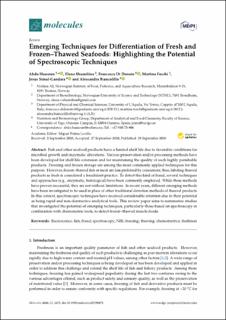| dc.contributor.author | Hassoun, Abdo | |
| dc.contributor.author | Shumilina, Elena | |
| dc.contributor.author | Di Donato, Francesca | |
| dc.contributor.author | Foschi, Martina | |
| dc.contributor.author | Simal-Gandara, Jesus | |
| dc.contributor.author | Biancolillo, Alessandra | |
| dc.date.accessioned | 2020-10-28T12:07:04Z | |
| dc.date.available | 2020-10-28T12:07:04Z | |
| dc.date.created | 2020-09-29T15:00:17Z | |
| dc.date.issued | 2020 | |
| dc.identifier.citation | Molecules. 2020, 25 1-21. | en_US |
| dc.identifier.issn | 1420-3049 | |
| dc.identifier.uri | https://hdl.handle.net/11250/2685497 | |
| dc.description.abstract | Fish and other seafood products have a limited shelf life due to favorable conditions for microbial growth and enzymatic alterations. Various preservation and/or processing methods have been developed for shelf-life extension and for maintaining the quality of such highly perishable products. Freezing and frozen storage are among the most commonly applied techniques for this purpose. However, frozen–thawed fish or meat are less preferred by consumers; thus, labeling thawed products as fresh is considered a fraudulent practice. To detect this kind of fraud, several techniques and approaches (e.g., enzymatic, histological) have been commonly employed. While these methods have proven successful, they are not without limitations. In recent years, different emerging methods have been investigated to be used in place of other traditional detection methods of thawed products. In this context, spectroscopic techniques have received considerable attention due to their potential as being rapid and non-destructive analytical tools. This review paper aims to summarize studies that investigated the potential of emerging techniques, particularly those based on spectroscopy in combination with chemometric tools, to detect frozen–thawed muscle foods. | en_US |
| dc.language.iso | eng | en_US |
| dc.publisher | MDPI | en_US |
| dc.rights | Navngivelse 4.0 Internasjonal | * |
| dc.rights.uri | http://creativecommons.org/licenses/by/4.0/deed.no | * |
| dc.title | Emerging Techniques for Differentiation of Fresh and Frozen–Thawed Seafoods: Highlighting the Potential of Spectroscopic Techniques | en_US |
| dc.type | Peer reviewed | en_US |
| dc.type | Journal article | en_US |
| dc.description.version | publishedVersion | en_US |
| dc.source.pagenumber | 1-21 | en_US |
| dc.source.volume | 25 | en_US |
| dc.source.journal | Molecules | en_US |
| dc.identifier.doi | 10.3390/molecules25194472 | |
| dc.identifier.cristin | 1835022 | |
| dc.relation.project | Nofima AS: 11878 | en_US |
| dc.description.localcode | © 2020 by the authors. Licensee MDPI, Basel, Switzerland. This article is an open access article distributed under the terms and conditions of the Creative Commons Attribution (CC BY) license (http://creativecommons.org/licenses/by/4.0/). | en_US |
| cristin.ispublished | true | |
| cristin.fulltext | original | |
| cristin.qualitycode | 1 | |

